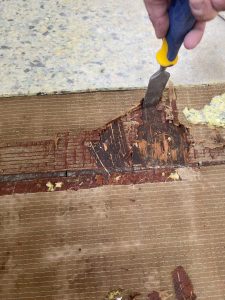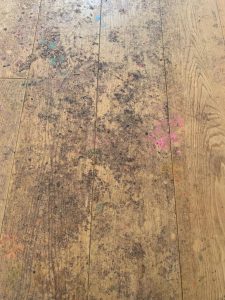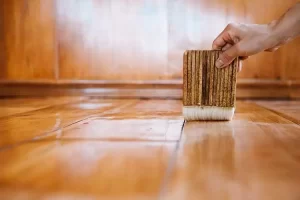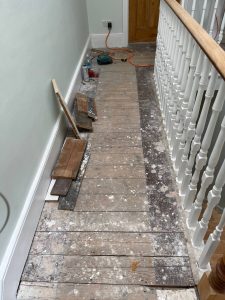How to Handle Floor Stains from Spills and Accidents

Spills and accidents are inevitable, especially in busy households and commercial spaces in London. Knowing how to effectively handle floor stains can help maintain the beauty and longevity of your floors. This guide will provide you with practical tips and techniques for dealing with common floor stains, ensuring your floors remain pristine.
Identifying the Type of Stain
Before treating a stain, it’s important to identify the type of stain you’re dealing with. Common floor stains include:
- Food and Beverage Stains: Coffee, wine, juice, and food spills.
- Pet Stains: Urine, vomit, and other accidents.
- Ink and Dye Stains: Ink spills, hair dye, and markers.
- Oil and Grease Stains: Cooking oil, motor oil, and grease.
General Tips for Handling Floor Stains

Regardless of the type of stain, these general tips can help you manage spills and accidents effectively:
1. Act Quickly
The sooner you address a spill, the easier it will be to remove the stain. Prompt action can prevent the spill from penetrating the floor’s surface.
2. Blot, Don’t Rub
Use a clean, absorbent cloth to blot the spill gently. Avoid rubbing, as this can spread the stain and push it deeper into the floor.
3. Use the Right Cleaning Solution
Choose a cleaning solution that is appropriate for your floor type. Always test a small, inconspicuous area first to ensure the cleaner doesn’t damage the surface.
Treating Specific Floor Stains
Food and Beverage Stains
For food and beverage spills, follow these steps:
- Blot the spill with a paper towel or cloth to remove excess liquid.
- Mix a solution of warm water and a mild dish soap.
- Apply the solution to the stain using a soft cloth and gently blot.
- Rinse with clean water and dry the area thoroughly.
Pet Stains
Pet stains can be challenging due to odour and potential discolouration. Here’s how to tackle them:
- Blot up as much of the stain as possible with a paper towel.
- Mix a solution of equal parts white vinegar and water.
- Apply the solution to the stain and let it sit for a few minutes.
- Blot the area with a clean cloth and rinse with water.
- For persistent odours, use an enzymatic cleaner designed for pet stains.
Ink and Dye Stains
To remove ink and dye stains, follow these steps:
- Blot the stain with a paper towel to absorb as much ink as possible.
- Dampen a cloth with rubbing alcohol and gently blot the stain.
- Rinse with water and dry the area thoroughly.
- If the stain persists, repeat the process or use a commercial ink remover.
Oil and Grease Stains
Oil and grease stains require a different approach:
- Blot up any excess oil with a paper towel.
- Sprinkle baking soda or cornstarch over the stain to absorb the oil.
- Let it sit for at least 15 minutes, then vacuum it up.
- Clean the area with a solution of warm water and dish soap.
- Rinse with water and dry thoroughly.
Preventing Future Stains
To keep your floors looking their best, consider these preventive measures:
- Use Mats and Rugs: Place mats at entryways and rugs in high-traffic areas to catch dirt and spills.
- Implement a No-Shoes Policy: Encourage family and guests to remove shoes before entering your home.
- Clean Spills Immediately: Promptly clean up any spills to prevent stains from setting.
- Regular Maintenance: Sweep, vacuum, and mop your floors regularly to remove dirt and debris.
Conclusion
Handling floor stains from spills and accidents doesn’t have to be a daunting task. By acting quickly and using the right techniques, you can keep your floors looking pristine. For professional floor maintenance and stain removal services in London, our experienced team is here to help. Contact us today to learn more about how we can assist you in maintaining the beauty of your floors.







Gallery 03 – Cork tile wood
[Read more...]
Sep
Floor Sanding for Commercial Properties: What You Need to Know
Floor sanding is not only essential for residential spaces but also plays a crucial role[Read more...]
The Benefits of Refinishing Your Wooden Floors
The Benefits of Refinishing Your Wooden Floors Enhance the Beauty and Value of Your[Read more...]
The Future of Floor Sanding: Emerging Trends and Technologies
The Future of Floor Sanding: Emerging Trends and Technologies Discover How Advancements Are Shaping[Read more...]
Wood floor nailing
[Read more...]
WOOD FLOORING SANDING AND OILING
[Read more...]
Floor sanding and renovation and installation services in Essex
Essex: A County of Charm and Diversity Essex is a historic and picturesque county located[Read more...]
The Best Lighting Options to Highlight Sanded Floors
The Best Lighting Options to Highlight Sanded Floors Enhance the beauty of your wooden[Read more...]
Wood Floor Restoration
[Read more...]
How to Achieve a Modern Look with Sanded Floors
How to Achieve a Modern Look with Sanded Floors Transforming your floors[Read more...]